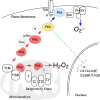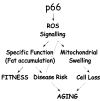P66Shc signals to age
- PMID: 20157533
- PMCID: PMC2806035
- DOI: 10.18632/aging.100057
P66Shc signals to age
Abstract
Oxygen metabolism is thought to impact on aging through the formation of reactive oxygen species (ROS) that are supposed to damage biological molecules. The study of p66(Shc), a crucial regulator of ROS level involved in aging dysfunction, suggests that the incidence of degenerative disease and longevity are determined by a specific signaling function of ROS other than their unspecific damaging property.
Keywords: Aging; Life span; degenerative disease; oxidative stress.
Figures



Similar articles
-
p66 Shc as the engine of vascular aging.Curr Vasc Pharmacol. 2012 Nov;10(6):697-9. doi: 10.2174/157016112803520747. Curr Vasc Pharmacol. 2012. PMID: 23259557 Review.
-
p66Shc, oxidative stress and aging: importing a lifespan determinant into mitochondria.Cell Cycle. 2008 Feb 1;7(3):304-8. doi: 10.4161/cc.7.3.5360. Epub 2007 Nov 20. Cell Cycle. 2008. PMID: 18235239 Free PMC article. Review.
-
The p66Shc knocked out mice are short lived under natural condition.Aging Cell. 2012 Feb;11(1):162-8. doi: 10.1111/j.1474-9726.2011.00770.x. Epub 2011 Dec 28. Aging Cell. 2012. PMID: 22081964
-
The p66(Shc) gene paves the way for healthspan: evolutionary and mechanistic perspectives.Neurosci Biobehav Rev. 2013 Jun;37(5):790-802. doi: 10.1016/j.neubiorev.2013.03.005. Epub 2013 Mar 20. Neurosci Biobehav Rev. 2013. PMID: 23524280 Review.
-
p66(ShcA): linking mammalian longevity with obesity-induced insulin resistance.Vitam Horm. 2013;91:219-41. doi: 10.1016/B978-0-12-407766-9.00009-2. Vitam Horm. 2013. PMID: 23374718 Review.
Cited by
-
Molecular and Cellular Mechanisms of Electronegative Lipoproteins in Cardiovascular Diseases.Biomedicines. 2020 Nov 29;8(12):550. doi: 10.3390/biomedicines8120550. Biomedicines. 2020. PMID: 33260304 Free PMC article. Review.
-
Activated protein C ameliorates diabetic nephropathy by epigenetically inhibiting the redox enzyme p66Shc.Proc Natl Acad Sci U S A. 2013 Jan 8;110(2):648-53. doi: 10.1073/pnas.1218667110. Epub 2012 Dec 24. Proc Natl Acad Sci U S A. 2013. PMID: 23267072 Free PMC article.
-
Modelling the p53/p66Shc Aging Pathway in the Shortest Living Vertebrate Nothobranchius Furzeri.Aging Dis. 2015 Mar 10;6(2):95-108. doi: 10.14336/AD.2014.0228. eCollection 2015 Mar. Aging Dis. 2015. PMID: 25821638 Free PMC article. Review.
-
Curcuma Longa, the "Golden Spice" to Counteract Neuroinflammaging and Cognitive Decline-What Have We Learned and What Needs to Be Done.Nutrients. 2021 Apr 30;13(5):1519. doi: 10.3390/nu13051519. Nutrients. 2021. PMID: 33946356 Free PMC article. Review.
-
p66Shc Protein-Oxidative Stress Sensor or Redox Enzyme: Its Potential Role in Mitochondrial Metabolism of Human Breast Cancer.Cancers (Basel). 2024 Sep 28;16(19):3324. doi: 10.3390/cancers16193324. Cancers (Basel). 2024. PMID: 39409944 Free PMC article.
References
-
- Luzi L, Confalonieri S, Di Fiore PP, Pelicci PG. Evolution of Shc functions from nematode to human. Curr Opin Genet Dev. 2000;10:668–674. - PubMed
-
- Pelicci G, Lanfrancone L, Grignani F, McGlade J, Cavallo F, Forni G, Nicoletti I, Grignani F, Pawson T, Pelicci PG. A novel transforming protein (SHC) with an SH2 domain is implicated in mitogenic signal transduction. Cell. 1992;70:93–104. - PubMed
-
- Ravichandran KS. Signaling via Shc family adapter proteins. Oncogene. 2001;20:6322–6330. - PubMed
-
- Lanfrancone L, Pelicci G, Brizzi MF, Aronica MG, Casciari C, Giuli S, Pegoraro L, Pawson T, Pelicci PG, Arouica MG. Over-expression of Shc proteins potentiates the proliferative response to the granulocyte-macrophage colony-stimulating factor and recruitment of Grb2/SoS and Grb2/p140 complexes to the beta receptor subunit. Oncogene. 1995;10:907–917. - PubMed
Publication types
MeSH terms
Substances
Grants and funding
LinkOut - more resources
Full Text Sources
Other Literature Sources
Medical
Miscellaneous
